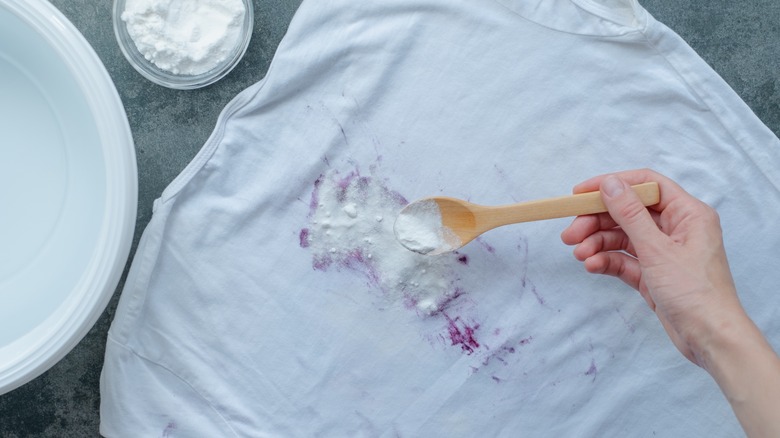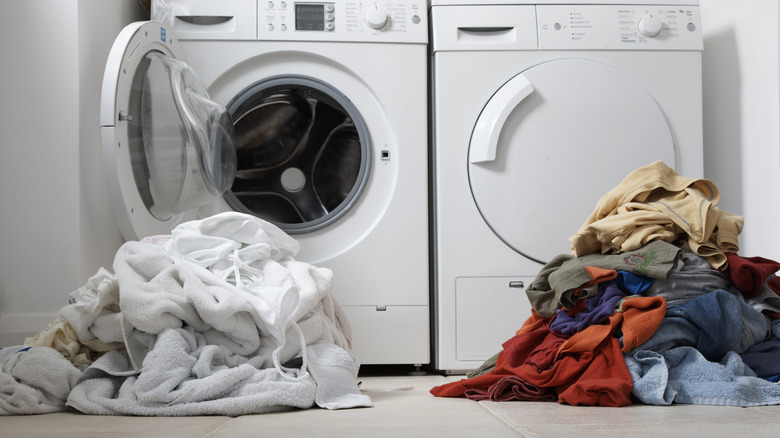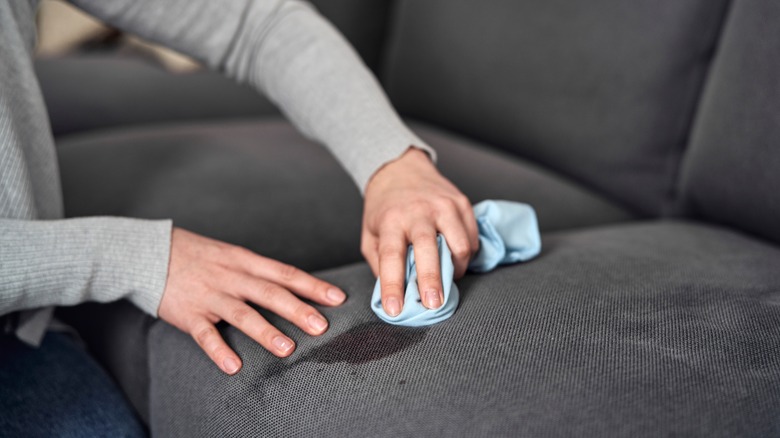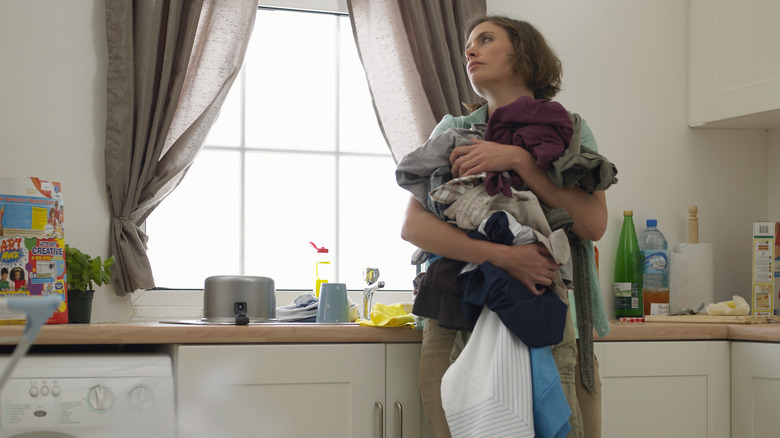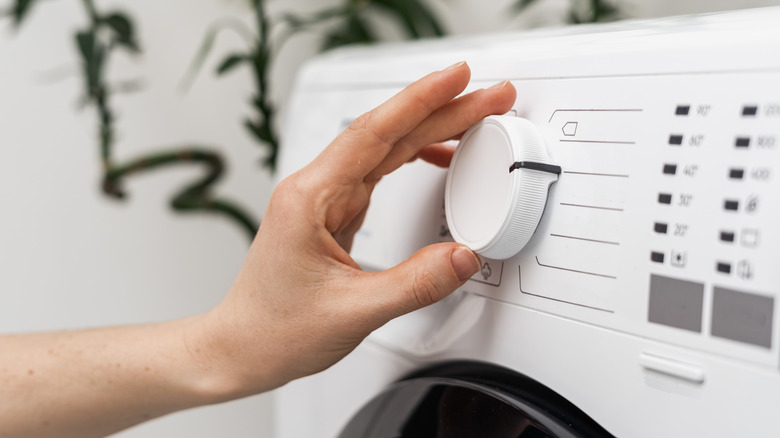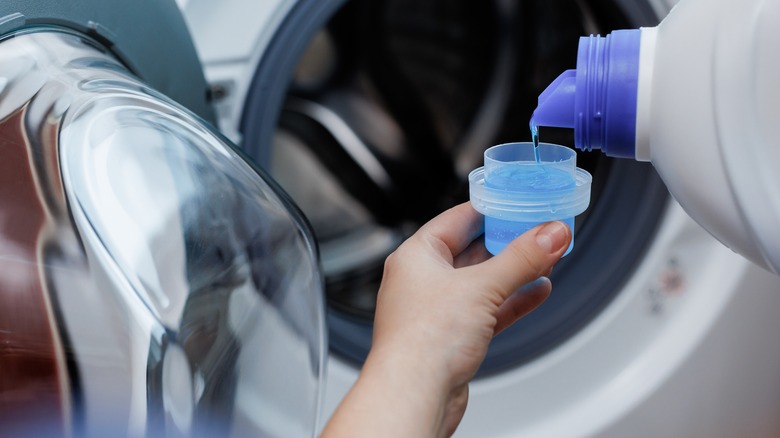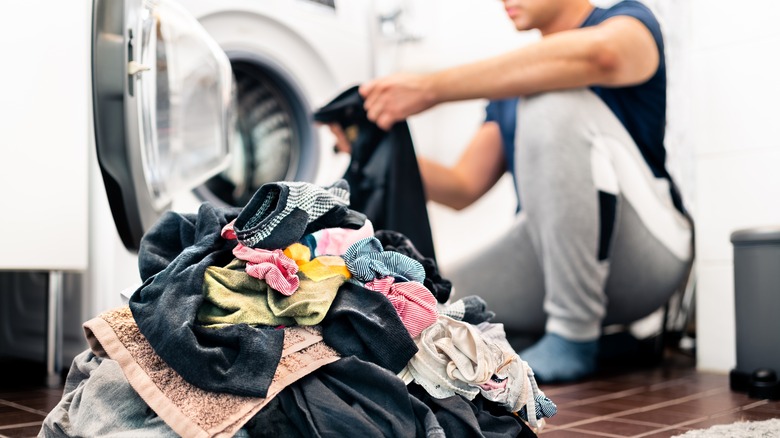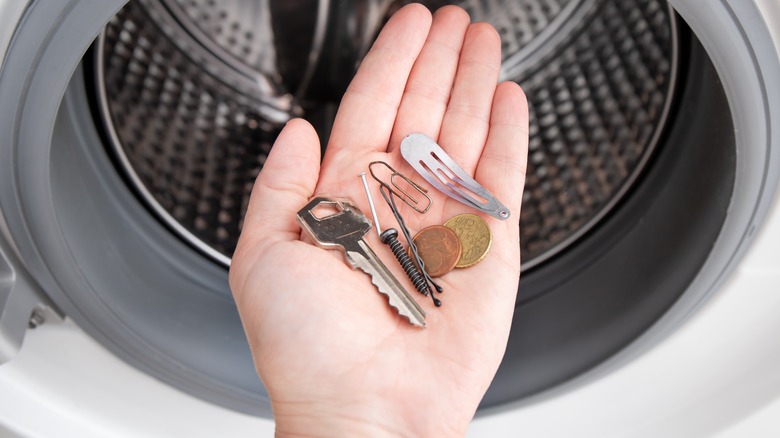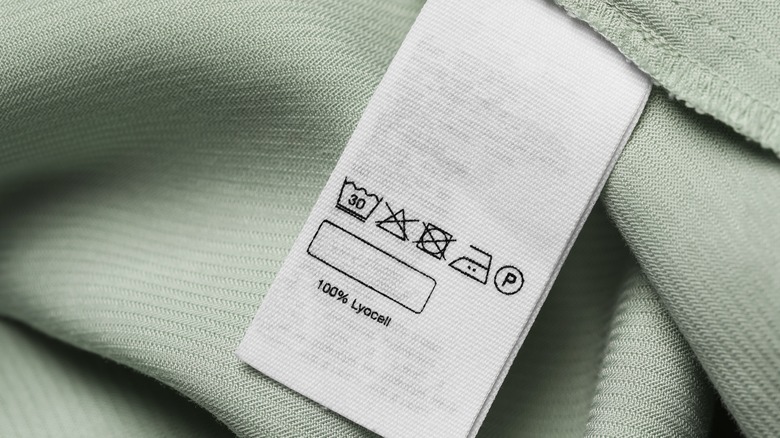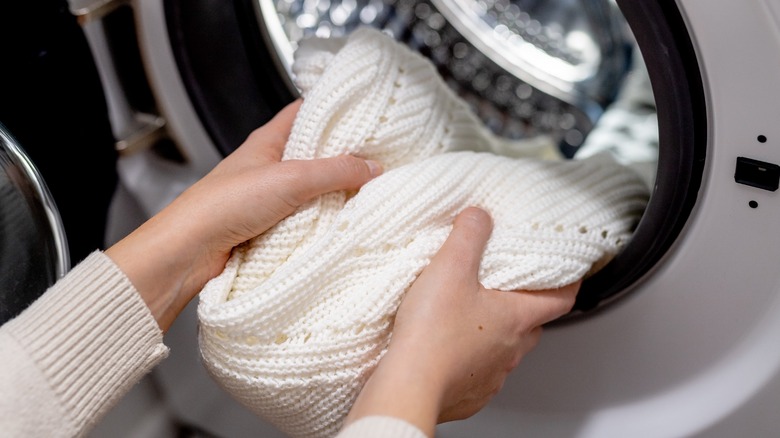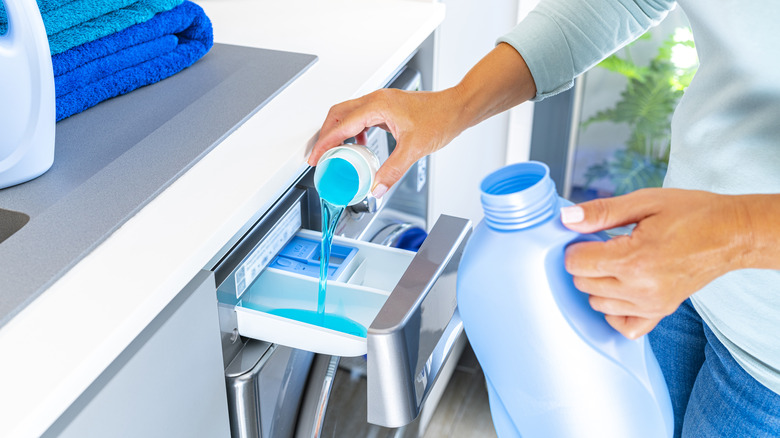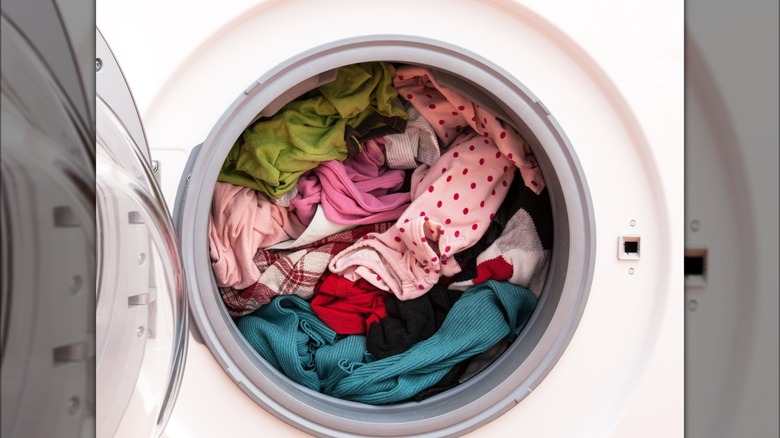Laundry Mistakes That Will Make Stains Way Worse
Chances are you're probably already doing some of these laundry mistakes that will make stains way worse. Of course, you don't mean to, but all your attempts in good faith to save grandma's sweater or your favorite silk napkins are likely ruining things — and you didn't even know! Sometimes common sense tips can save our laundry. That is, taking care of the stains as soon as they happen, instead of trying to tackle them a few days later — plus, not putting heavily-stained items in the dryer until you are sure they are clean.
Yet, sometimes saving your favorite clothes from the brink after a messy BBQ lunch will require a little bit more know-how. That's where we come in. These are the most common mistakes folks make with stains. After reading this, you'll never do them again — ruined clothing and hours wondering why the stains aren't lifting will be a thing of the past. Here is how to get rid of stains and do your laundry the right way, once and for all.
Ignoring stains for too long
The longer you leave a stain to sit, the harder it will be to get it out. The science behind this is pretty simple: The more time you give the stain to bond with its new host, the stronger the bond will be. If it's possible, address the stain as soon as it happens. This is the case for things that are especially precious, like a favorite dress or school uniform. This might look like nipping to the bathroom to dab out a lunch stain, or popping the wine-soaked tablecloth straight into the washing machine — even if it disturbs dinner a little. The sweet spot for most stains is to attack them before they have a chance to air dry, and thus set themselves. Having a small pre-treating pen in your purse or desk makes this step easier.
If you haven't gotten to the stain right away (we do all have lives!), it's still possible to get rid of it. It'll just take a bit more strategy and elbow grease. This includes mixing your favorite stain remover with water in a large tub (bathtub, washing machine, or galvanized bucket — you can choose) and soaking for up to six hours. After each soak, you can dab the stain and rewash, to see if you've made progress. However, by getting to the marks sooner rather than later, removal isn't nearly as hard.
Rubbing stains vigorously
When you spill something on yourself, your first instinct might be to rub the stain out as quickly as you can. Yet, sometimes this is a mistake that can just make things worse. This is because rubbing stains might spread them and push them deeper into the fabric fibers. Even if you shouldn't scrub the stain, this doesn't mean just leave it alone and hope for the best. Instead, pause and assess the stain. There are still a few things you can do based on the type of stain it is.
In most cases, all stains respond well to dabbing, instead of wiping. The dabbing action does more to soak up the offending liquid rather than spreading it all around or pushing it deeper. This should be performed with a clean, dry cloth. Yet, for certain types of stains, you can do a little more, so the first step is to determine what kind of stain it is.
If it's a water-based stain like coffee, tea, fruit juice, or fruit, you can dab it with vinegar or dish soap. If it's a protein stain like from egg, dairy products, or vomit, you can rinse it a little, but letting it dry and lightly dabbing of the dried excess is your best bet. If it's oil-based, dry cleaning is typically a good choice, because of the chemicals used. No matter the stain, remember: Don't rub it in!
Not pre-treating stains
When you have a really bad stain, don't toss the item, completely unrinsed, into the washing machine. You are doing yourself a real disservice by approaching laundry this way. For most fabrics, skipping pre-treatment can make it harder for the detergent to penetrate the fibers and lift the stain. These come in many options, like Tide to go pens, small packs of wipes, or even pre-treat spray or gel that you can keep in the laundry room at home. It's not as important what form of pre-treatment you use, just that you use it.
What is important is that you pay attention to the instructions on the packaging, as different types of pre-treatment can work quite differently. Enzyme stain removers help bring a stain out of fabric, so you can dab it right off, while simple stain removers just give detergent more help, so you will need to wash the item soon after. Some require some time to soak in, others can be washed almost immediately. It's a mistake to skip pre-treating, but it's even more of a mistake to assume they all work the same way and skip the instructions. Don't overlook them — you need them even if you think you're a laundry pro.
Using the wrong water temperature
Certain stains respond better to cold or warm water, so before you start trying to remove a mark, it's best to investigate. Better yet, know the ideal temperatures for each stain ahead of time, so you can act quickly. After dabbing the stain, keep this cheat sheet from Molly Maid in mind. Stains to soak in cold water are baby food/formula, blood, cheese, chocolate, coffee and tea, jelly and jam, dairy products, paint (water-based), sodas, soy sauce, urine, and alcoholic drinks of any kind. Hot water should be used to handle dirt/mud, dye and marker, egg, grass, grease, oil, tomato-based products, lotion, mustard, sweat, shoe polish, and vomit.
Of course, if you mess up and use the wrong water temperature at first, it's not the end of the world. It's better to use cold than hot, as heat can set stains — so start chillier and warm up if you aren't sure the setting to use.
Using bleach on certain stains
You might think that bleaching a stain is one of the best ways to get rid of a tough one, especially on a white garment. However, bleach can react with some stains and make them even worse. This usually happens with stains that contain ammonia, like sweat or urine. The bleach makes these dark, grimy marks even darker. It also has the same impact on rust-stained fabric. The yellowing of whites is often inevitable, but it doesn't have to be permanent.
So, if you're cleaning sheets after a bed-wetting incident, or freshening up the armpits on your tennis outfit, you can definitely use bleach to sanitize the fabrics — but it won't make them look any better. Instead, to lift the stains and restore the item, reach for more natural solutions like salt, lemon juice, and a touch of bright sunlight to dry things out. A mixture of baking soda and peroxide will also tend to bubble up enough to do the trick.
Skipping sorting leads to discoloration
You've likely seen it in the movies: How one red sock turns an entire load of white laundry pink. Although you might think this is some sort of laundry myth, it really does happen. The same can be said of blue jeans that have never been washed before. The colors can, and often do, run! It's an easy way to ruin your clothing. This happens the most in warm water washes, as the temperature of the water can loosen the bond between dye and fabric, causing a bit of mixing. Luckily, it's easy to avoid.
The first step is separating your laundry into similar colors and fabrics. You might do a load of whites that you can bleach, a load of lights, darks, and delicates, plus heavy fabrics like towels and sheets. These heavy loads should be sorted by color as well, so you don't ruin anything. If you do, white can usually be saved by being run through another wash with a little bit of bleach. Any other colors will need to be soaked for at least 30 minutes in hot water and color-safe bleach or strong laundry soap, then immediately rinsed. Repeat the process as many times as you need to until the stain is gone.
Not checking pockets
There are few things less annoying than working so hard to get a stain out of clothes, only to pull them out of the washing machine with a brand new stain on them — all because you forgot to check the pockets. There are many things that can cause this: an ink pen in your work shirt's front pocket, a packet of gummy snacks in your preschooler's shorts. Even a red sock that somehow got tangled up with your jeans the last time they were in the dryer together.
Yes, it can be frustrating to add more time onto the chore by rifling through every item's pockets. However, you will save yourself from the headache of dealing with a new stain, because of an accident the one time you forgot to look. As an incentive, especially if you are responsible for the household's laundry, enforce a finder-keepers rule for everything that comes out of the washing pile. This includes, but is not limited to, money, debit cards, jewelry, and the like. While these things don't tend to cause stains, they make looking for them a bit more worth it.
Ignoring care labels
You might think that a lot of stain care is just common sense. However, when it comes to getting rid of stains without damaging the fabrics they are attached to, it might not be. Because of the consistency of different fibers (silk, cotton, polyester, etc.), stains might act differently on different fabrics. What will work on a cotton t-shirt might absolutely ruin a silk blouse. To keep your clothing safe from unintended harm, you need to pay attention to what's on its care label. When you spill something, taking a quick glance at the inside tag can save you a lot of frustration — and it should be one of the first things you do.
For example, if you dribble BBQ sauce on a wool sweater, reading the label can help you understand if it's actually a faux blend that can be washed on the delicate cycle — or if you need to work on it by hand in your utility sink. It's the same for a glass of red wine across the tablecloth or grass ground into your soccer socks. The label will let you know if it's dry clean only, if warm water will make it shrink, or you don't need to think twice and can do whatever you think is best. If there is no care label, or you have the item second hand and someone cut it out, it never hurts to do a quick Google search to double check the risks.
Leaving stained clothes in the dryer
Never put clothing with a stain on it in the dryer. This is because heat from the dryer can set stains, making them more difficult to remove later on. It doesn't mean that the stain can never come out, but it's just going to be harder and take a lot more effort. The tricky part is that sometimes stains don't show up on wet clothing. You might think you've succeeded in cleaning something when you really haven't. So, if you are working on getting a stain out of something, let it air dry. Then check again to make sure the mark truly is gone. This way, you avoid the disappointment of pulling your new tablecloth out of the dryer only to realize you've just made so much more work for yourself.
If you forgot to check, or didn't notice the mark until later, don't panic. You can still start the process over using bleach for whites, or color-safe bleach for other fabrics. You will just need to soak the stain for up to 10 minutes before washing it again. For older stains, you might have to repeat this process more than once to see any progress. This can be discouraging, but the more you work at the stain, the lighter it should get — even if it doesn't go away completely.
Using hacks instead of laundry supplies
Sometimes when we are desperate to get a stain out of something, we will try anything. This includes scouring the internet for the latest laundry hacks, so we can save our favorite t-shirt. While some of these ideas might work wonders to make your clothes smell better, some of them are down right dangerous and might even cause a house fire. It can be tempting to do anything and everything to get rid of stains, but it's a laundry mistake to do anything outside the tried and true basics.
Things like hairspray can actually make stains even worse, as can nail polish remover, if you use a colored one, as the dye will seep into the clothing. When trying to get rid of stains, it's always best to start with soap and mainstream laundry stain products before branching out. If following a laundry hack, especially from a source like TikTok or other social media — pause first. Double check the account for trustworthiness. Is it a real person showing how they do laundry, or a voiceover with stock images? Check the comments, too — have other experienced success? Sometimes you can even check out the stitches of the video to see if others in the community think the hack works.
Using too much fabric softener
Fabric softener is a great tool for breathing new life into old and scratchy fabrics, but there can always be too much of a good thing. In fact, if you love how your favorite fabric softener makes your clothes look and feel, you might be making a laundry mistake that will ruin all your other clothes over time. "Overuse of fabric softeners over time starts to build a film and deposits [that] start to slow down drain time. It can actually start to fill the drain lines and then you get other dirt, debris, grime and things from the clothes that we pick up from the environment [that] start to cling even more," James Copeland, director of technical services for Prism Specialties, told TODAY.
This means that your washing machine is doing less cleaning each time you use it, which is a bummer. "So you start to get these inefficiencies and these inefficiencies affect the operation of the equipment [and] shorten the life cycle of the equipment," Copeland continued. Even worse, these build-ups can make your machine start to stink. This stench is the opposite of getting stained clothes fresh. The best thing you can do is to avoid fabric softener in every wash. For example, try using it on your sheets every third wash, instead of each time. There are also holistic alternatives to try, like baking soda and vinegar, that don't tend to impact your machine.
Overloading the washer
We get it: Electricity and water bills seem like they just keep going up. You might be tempted to overload your washing machine so you don't have to do as many loads of laundry. Unfortunately, this strategy isn't going to get you the results you are hoping for. Instead, overloading your washing machine just crowds items together. This makes it more difficult for the soap and water to reach all parts of the fabric and do their jobs effectively. You might end up with a stain that is still just as bad as when it went into the wash, because it was too isolated for any progress to happen. You can also break your machine by filling it too full, as this puts extra pressure on the drum — making the appliance work way harder than it needs to for often mediocre results.
A good rule of thumb when loading your washing machine is to leave it about halfway empty. Whether you have a front loader or top loader, you should be able to eyeball the halfway point. Yes, there are complicated math equations you can do to find the perfect load size based on the size of your machine's drum, but you don't need to worry about them. Do a quick visual check for the halfway point (without squashing clothes down to fit!) and you should be just fine.
